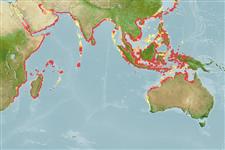>
Eupercaria/misc (Various families in series Eupercaria) >
Nemipteridae (Threadfin breams, Whiptail breams)
Etymology: Scolopsis: Greek, skolex = worm + Greek, opsis = appearance (Ref. 45335); vosmeri: Name from the acronym of the Indira Gandhi Centre for Atomic Research (IGCAR), Kalpakkam, where it was first collected..
More on author: Bloch.
Environment: milieu / climate zone / depth range / distribution range
นิเวศวิทยา
เกี่ยวกับทะเล,น้ำเค็ม เกี่ยวกับหินโสโครก; ระดับความลึก 2 - 25 m (Ref. 9710). Tropical
Indo-West Pacific: from the Red Sea and East Africa to Pakistan, India, Sri Lanka, Bangladesh, Myanmar and Thailand (Andaman Sea), extending to western Indonesia and Borneo, the Philippines and New Guinea (Also Ref. 120578).
ขนาด / น้ำหนัก / Age
Maturity: Lm ? range ? - ? cm
Max length : 25.0 cm TL เพศผู้/กระเทย; (Ref. 4427); common length : 15.0 cm SL เพศผู้/กระเทย; (Ref. 3810)
เงี่ยงครีบหลัง (รวม): 10; ก้านครีบอ่อนที่หาง (รวม): 9; เงี่ยงครีบก้น 3; ก้านครีบอ่อนที่ก้น: 7; สัตว์มีกระดูกสันหลัง: 22. This species is distinguished by the following set of characters: scaly temporal region with scales on top of head reaching forward to just in front of the anterior nostrils; naked suborbital; the lower margin of the eye is tangent to or just above a line from snout tip to upper pectoral-fin base; exposed bony ridge below the eye with an antrorse and retrorse spine; scales on preopercle are extending to posterior margin, scales behind suborbital 5-6 rows and behind eye 3-4 rows; the lower limb of preopercle usually has a single row of embedded scales; scales on opercle 4-7 rows; most body scales (except for caudal peduncle) have a black spot; caudal peduncle white; usually a white band is present beneath lateral line, from origin of lateral line to below posterior part of dorsal fin; from nape onto operculum is a broad white bar, and suborbital with distinctive white patch - all these not present in juveniles and smaller subadults; upper limb of opercular margin narrowly brown, the lower limb narrowly reddish-orange; upper base of pectoral fin with a small dark spot; pelvic and anal fins are crimson or orange-red (Ref. 120656).
Benthic in inshore turbid or weedy waters, usually on sand or mud or rubble bottoms close to reefs (Ref. 30573, 90102, 92980), as well as offshore areas (Ref. 9785). Seen solitary, but may school deep (Ref. 48635). Feeds on benthic organisms (Ref. 5213). Marketed fresh, salted, smoked or processed into fish balls (Ref. 12484).
Life cycle and mating behavior
วัยเจริญพันธุ์ | การสืบพันธุ์ | การวางไข่ | เซลสืบพันธ์ของเพศเมีย(ไข่) | ความดกของไข่ | ตัวอ่อน
Russell, B.C., 1990. FAO Species Catalogue. Vol. 12. Nemipterid fishes of the world. (Threadfin breams, whiptail breams, monocle breams, dwarf monocle breams, and coral breams). Family Nemipteridae. An annotated and illustrated catalogue of nemipterid species known to date. FAO Fish. Synop. 125(12):149p. Rome: FAO. (Ref. 3810)
IUCN Red List Status (Ref. 130435)
Threat to humans
Harmless
Human uses
การประมง: การค้า; การตกปลาเป็นกีฬา: ใช่
ข้อมูลเพิ่มเติม
ชื่อสามัญชื่อพ้องกลไกการเผาผลาญพลังงานผู้ล่าการศึกษาเกี่ยวกับผลกระทบของสารประกอบทางเคมีที่เป็นอันตรายต่อสิ่งมีชีวิต ประชากร และสิ่งแวดล้อมการสืบพันธุ์วัยเจริญพันธุ์การวางไข่การรวมกลุ่มวางไข่ความดกของไข่เซลสืบพันธ์ของเพศเมีย(ไข่)Egg development
อ้างอิงการเพาะเลี้ยงสัตว์น้ำประวัติการเพาะเลี้ยงสัตว์น้ำสายพันธุ์พันธุศาสตร์ElectrophoresesอัตราพันธุกรรมโรคการแปรรูปNutrientsMass conversion
เครื่องมือ
Special reports
Download XML
แหล่งที่มาจากอินเตอร์เน็ต
Estimates based on models
Preferred temperature (Ref.
123201): 25.4 - 29.3, mean 28.6 °C (based on 2454 cells).
Phylogenetic diversity index (Ref.
82804): PD
50 = 0.5000 [Uniqueness, from 0.5 = low to 2.0 = high].
Bayesian length-weight: a=0.01514 (0.00834 - 0.02746), b=3.03 (2.88 - 3.18), in cm total length, based on LWR estimates for this species & Genus-body shape (Ref.
93245).
ระดับชั้นอาหาร (Ref.
69278): 3.5 ±0.37 se; based on food items.
ความสามารถในการกลับคืนสู่ปกติ (Ref.
120179): ความสูง, เวลาต่ำสุดที่จะทำให้ประชากรเพิ่มขึ้นเป็น 2 เท่าใช้เวลาน้อยกว่า 15 เดือน (Preliminary K or Fecundity.).
Fishing Vulnerability (Ref.
59153): Low vulnerability (15 of 100).
Nutrients (Ref.
124155): Calcium = 64 [40, 132] mg/100g; Iron = 0.686 [0.339, 1.648] mg/100g; Protein = 19 [17, 21] %; Omega3 = 0.144 [0.087, 0.239] g/100g; Selenium = 26.1 [15.3, 47.0] μg/100g; VitaminA = 78.8 [22.0, 230.3] μg/100g; Zinc = 1.35 [0.93, 1.95] mg/100g (wet weight);
